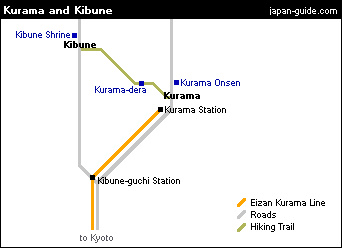Kyoto (Northern)
Kinkakuji
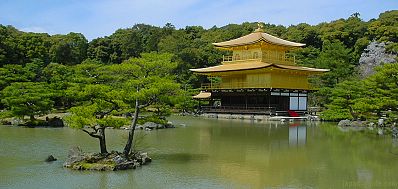
Kinkakuji (Golden Pavilion) is a Zen temple formally known as Rokuonji.
In 1397 construction started on the Golden Pavilion as part of a new residence for the retired shogun Ashikaga Yoshimitsu. Kinkakuji was converted into a Zen temple after Yoshimitsu's death in 1408.
The Golden Pavilion functions as shariden, housing sacred relics of the Buddha and is covered in gold leaf. The present building dates from 1955 as the pavilion was burnt by a fanatic monk in 1950.
Kinkakuji can be accessed by direct bus number 101 or 205 from Kyoto Station. A faster variant is taking the Karasuma Subway Line to Kitaoji Station from where the temple can be reached in a short bus or taxi ride.
Ryoanji
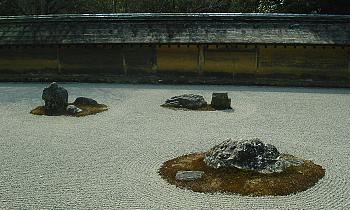
Ryoanji is a Zen temple in northwestern Kyoto.
The temple's main attraction is its rock garden, the most famous of its kind in Japan. The simple Zen garden consist of nothing but rocks, moss and neatly raked gravel. The meaning of the garden's arrangement is unknown and up to each visitor's interpretation.
Ryoanji is a 5 minute bus ride or 15 minute walk west of Kinkakuji, the Golden Pavilion.
Ryoanji can also be reached by the Keifuku Kitano Line, a small train that runs through the calm residential areas of northwestern Kyoto and offers a connection to Arashiyama. To access Ryoanji, get off at Ryoanji-michi Station from where it is a 5 minute walk to the temple.
Ninnaji
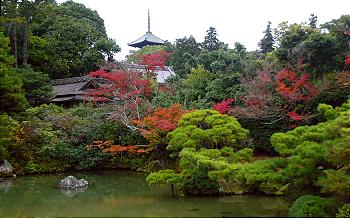
Ninnaji is one of Kyoto's most interesting temples, featuring a large variety of different buildings and gardens on its spacious grounds. It belongs to Kyoto's UNESCO world heritage sites.
Ninnaji was founded in the year 888 as an imperial residence, but, like most historic buildings in Japan, suffered repeated destruction in wars and fires over the centuries. Today, Ninnaji is the headquarters of the Omuro school of the Buddhist Shingon sect.
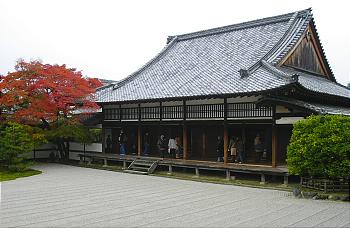
Among the numerous buildings on the temple grounds, are elegant palace style buildings surrounded by beautiful Japanese gardens, a five storied pagoda, various temple halls, a massive entrance gate, bell tower and tea houses.
Ninnaji is also famous for a rare, locally cultivated type of cherry tree, named Omuro Cherry. Many Omuro cherry trees, whose blossoms open relatively late during the hanami season, stand on the temple grounds and attract many spectators.
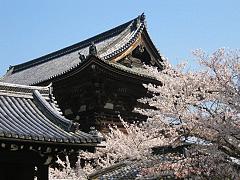 | 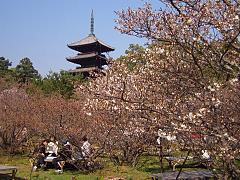 |
Ninnaji is a 5-10 minute walk west of Ryoanji and just a few steps from Omuro Station on the Keifuku Kitano Line, a small, tram like train, which connects Arashiyama with the Kitano district.
Daitokuji
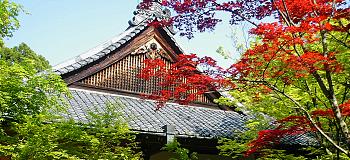
Daitokuji is the head temple of the Rinzai sect's Daitokuji school within Japanese Zen Buddhism and is considered one of the best places to experience Zen in Japan.
Daitokuji is surrounded by many subtemples, which together form a kind of temple village. The main temple and some of the subtemples are open to the public and display Zen architecture and design, including gardens and tea ceremony rooms.
Among the most interesting subtemples are Kotoin, which is famous for its maple trees (particularly spectacular when the leaves turn color, usually in mid November) and Daisenin, whose small rock garden is considered one of the best.
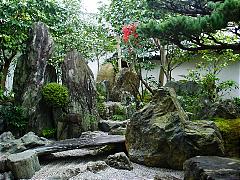 | 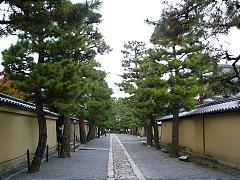 |
From Kyoto Station, Daitokuji is best accessed by the Karasuma Subway Line to Kitaoji Station, from where the temple complex is a 5 minute bus or taxi ride or a 15 minute walk.
Toei Uzumasa Eigamura
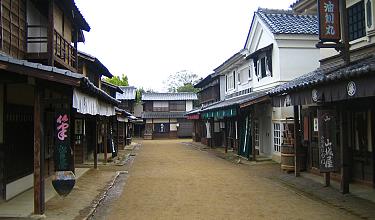
The Toei Uzumasa Eigamura (also known as Kyoto Studio Park and Toei Movie Land) is a film set and theme park in one. It features a collection of replicas of traditional Japanese buildings which are used as setting for historical movies and television dramas.
There are whole streets depicting Edo Period town scenes, a replica of the old Nihonbashi Bridge, a traditional court house, a Meiji Period police box and part of the former Yoshiwara red light district. Actual film shooting takes place occasionally, and park visitors are welcome to observe the action.
Other attractions include various performances, a haunted house, a large souvenir shop and exhibitions about popular TV series. It is also possible to dress up and get photographed in more than 30 attires including samurai, geisha and ninja attires. The cost varies from 8500 to 16000 Yen depending on the attire.
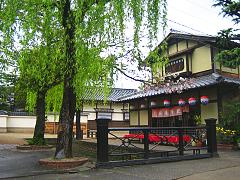 | 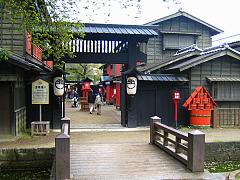 |
The Toei Eigamura is a 5 minute walk from Uzumasa Station on the Keifuku Arashiyama Line (10 minutes, 200 Yen from Shijo-Omiya or Arashiyama) or a 15 minute walk from JR Hanazono Station (10 minutes, 190 Yen from Kyoto Station).
It can also be reached in about half an hour by Kyoto City Bus 75 or Kyoto Bus 71, 72 or 73 from Kyoto Station or by Kyoto City Bus 11 or 91 or Kyoto Bus 61, 62 or 63 from Shijo Avenue in central Kyoto.
Enryakuji
Enryakuji on Hieizan, a wooded mountain northeast of Kyoto, has been one of the most significant monasteries in Japanese history. It is the headquarters of the Tendai sect, the Buddhist sect that served as foundation for a number of later evolving sects including the Pure Land (Jodo), Zen and Nichiren sects.
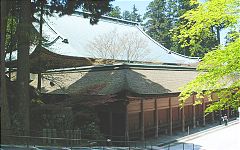 | 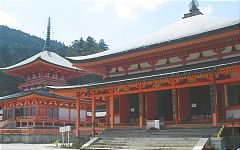 |
Saicho, who introduced the Tendai sect to Japan, founded Enryakuji in 806. At its peak, Enryakuji had as many as 3000 subtemples and a powerful army of warrior monks who were not seldomly engaged in power struggles with other monasteries and political leaders.
On his way to remove all potential rivals and unite the country, Oda Nobunaga attacked and destroyed most of Enryakuji's buildings and monks in 1571.
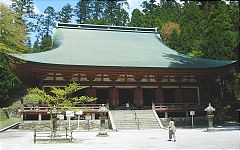 | 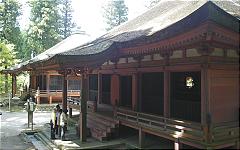 |
Today, most of Enryakuji's attractions are concentrated in three areas: Todo (East area) where Enryakuji was originally founded, Saito (West area) which can be reached from Todo in a pleasant 20 minute walk through the forest, and the more distant and less spectacular Yokawa area.
By train, there are two possible routes: The first route approaches the mountain from the Kyoto side by Eizan Railways from Demachi-Yanagi Station to the foot of the mountain (15 minutes, 260 Yen), from where there is a cablecar (1040 Yen round trip) followed by a ropeway (600 Yen round trip).
The second route approaches the mountain from the Lake Biwa side by the JR Kosei Line to Hiei Sakamoto Station (15 minutes, 320 Yen one way). The Sakamoto Cablecar then leads up the mountain (1570 Yen round trip). It is a 15 minute walk or 5 minute bus ride from the JR to the cable car station.
There are also some infrequent direct buses to the top of Mount Hiei from Kyoto Station (operated by Kyoto Bus) and Keihan Sanjo Station (operated by Keihan Bus). The one way trip takes about one hour and costs around 800 Yen.
Ohara
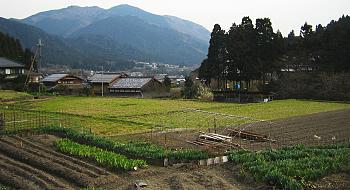
Ohara is a rural town in northern Kyoto City, about one hour north of Kyoto Station. Ohara's main attraction is Sanzen-in Temple.
Sanzen-in's principal object of worship, a golden statue of the Amida Buddha, is displayed in the Ojo-Gokuraku-in, the temple's much photographed wooden building in the moss covered garden. Sanzen-in is particularly attractive (but also crowded) during the autumn leaf season, which usually peaks in mid November.
The pleasant road from the Ohara bus stop to Sanzen-in leads along a small river and is lined by numerous souvenir shops. Among the local specialties offered are various pickles, including "Ice Kyuri", Japanese cucumbers mildly pickled in seaweed flavored ice water.
 |  |
Another famous temple in Ohara is Jakko-in. The temple was destroyed in an arson attack in the year 2000, but reconstruction works on the temple have been completed in 2005. It is said that the temple was founded by Shotoku Taishi in the seventh century.
Since 2004, Ohara has its own hot spring water, pumped to the surface from a depth of more than one kilometer. The water can be enjoyed at two local ryokan, Ohara no Sato and Ohara Sanso, not far from Jakko-in. If you do not stay at the ryokan, you can use the baths in combination with a snack or meal (advance reservation recommended).
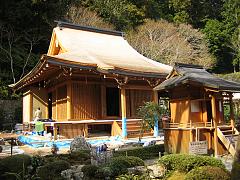 | 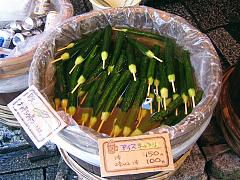 |
From Kyoto Station, take the Karasuma Subway Line to its terminal station Kokusaikaikan Station (20 minutes, 260 Yen). From there take Kyoto Bus number 19 (bound for Ohara or Kodeishi) to Ohara (20 minutes, 340 Yen, two buses per hour).
Alternatively, take Kyoto Bus number 17 (bound for Ohara) directly from Kyoto Station to Ohara (60 minutes, 580 Yen, three buses per hour). This bus also stops at Shijo-Kawaramachi in the city center (45 minutes, 510 Yen to Ohara).
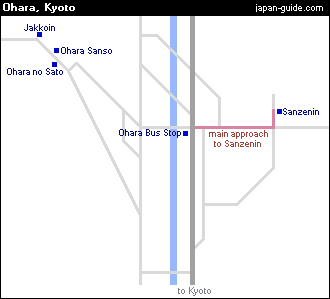
Kurama
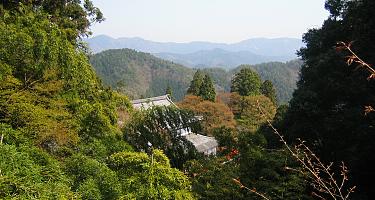
Kurama is a rural town in the northern mountains of Kyoto City, less than one hour from the city center. Kurama is best known for its temple Kurama-dera and its hot spring, one of the most easily accessible hot springs from Kyoto.
Outdoor and indoor baths can be enjoyed at Kurama Onsen, a ryokan located at the upper end of the town of Kurama. It can be reached in a 10 minute walk from the train station along the town's only road or along a nature trail following the river.
Guests, who are staying at the ryokan, can use the baths for free, while daytrippers pay 2500 Yen per person to use all of them or 1100 Yen per person to use the outdoor pool (rotemburo) only.
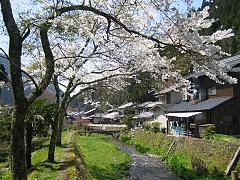 | 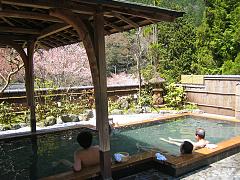 |
Kurama's main attraction, Kurama-dera, is a Buddhist temple located in the wooded slopes above the town. From its main gate in the town's center, the main buildings can be reached in a 30-45 minute climb up the mountain. A cablecar (200 Yen one way) leads halfway up.
Along the ascent to Kurama-dera stands Yuki Jinja, a shrine famous for its Fire Festival (Kurama Hi Matsuri), held annually on October 22. Kurama-dera's main buildings stand on a terrace on the mountain's slope, overlooking the wooded valley.
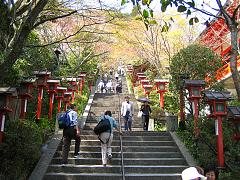 | 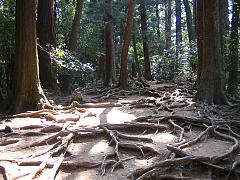 |
Behind the temple's main building, the hiking trail continues through the forest past several other temple structures to Kibune, a small town in the neighboring valley. The hike from Kurama-dera to Kibune is steep at times and takes about one hour.
Kibune offers several ryokan and restaurants, which serve meals on terraces built along the river during the warmer months of the year. At Kibune Shrine you can obtain a unique type of omikuji (fortune telling paper slips) that displays your fortune after it has been dipped into the water.
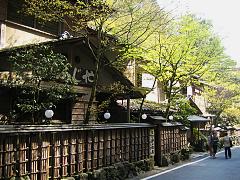 | 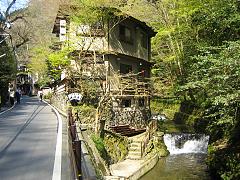 |
Kurama is connected with central Kyoto by Eizan Railway. The one way trip along the Eizan Kurama Line from Demachi-Yanagi Station to Kurama Station takes 30 minutes and costs 410 Yen. Trains depart every 15 to 20 minutes.
In order to access Kibune, get off at the second last station, Kibune-guchi Station, from where you can walk to Kibune along the road in about 20-30 minutes or take Kyoto Bus number 33 (5 minutes, 160 Yen).
The fastest way to reach Demachi-Yanagi Station from Kyoto Station is by taking the JR Nara Line to Tofukuji Station (140 Yen, 2 minutes), where you can transfer to the Keihan Main Line to Demachi-Yanagi Station (260 Yen, 10 minutes).
